ASTRONOTES
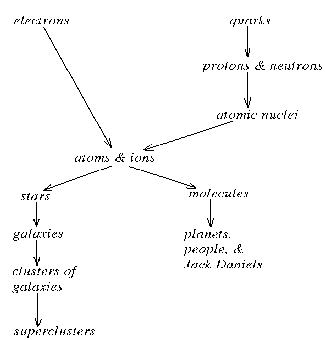 |
| Force | Type | Distance Scale |
|---|---|---|
| Gravitational | Attractive | Planetary to cosmic |
| Electromagnetic | Attractive, repulsive | Atomic to human + |
| Strong | Attractive | Nuclear |
Small Structure of the Universe
| Mass | Electric Charge |
Electron | ~1/2,000 | -1 |
|---|---|---|---|
| "Up" Quark |  |
~1/3 ? | +2/3 |
| "Down" Quark |  |
~1/3 ? | -1/3 |
| Mass | Electric Charge |
||
|---|---|---|---|
| Proton |  |
1 | +1 | Neutron |  |
1 | 0 |
| A Mass |
Z Electric Charge |
Hydrogen (1H) |
 |
1 | +1 |
|---|---|---|---|
| Helium (4He) |
 |
4 | +2 | Carbon (12C) |
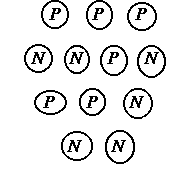 |
12 | +6 |
| Mass | Electric Charge | ||
|---|---|---|---|
| Hydogen Atom |
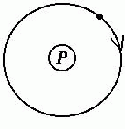 |
1 | 0 |
| Helium Atom |
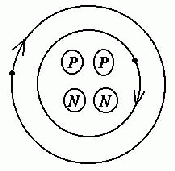 |
4 | 0 |
| Helium Ion |
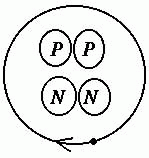 |
4 | +1 |
| Mass | Electric Charge |
||
|---|---|---|---|
| Oxygen Molecule (O2) |
 |
32 | 0 |
| Water (H20) |
 |
18 | 0 |
| Ethanol (C2H60) |
 |
46 | 0 |
The Solar System |
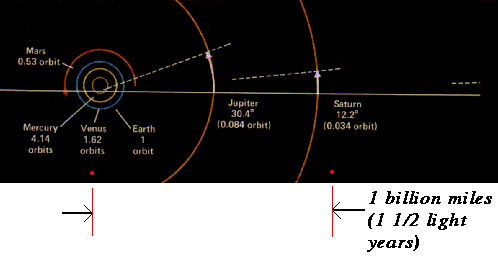 |
|
| * Sun * 9 Major Planets * Satellites, Asteroids, Comets, etc. |
The
Sun - A star... a glowing globe of gas | Planets
- Much smaller, solid and liquid composition |
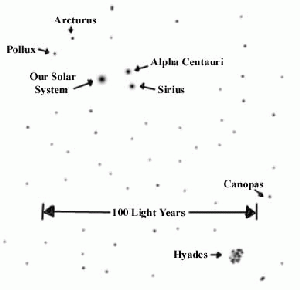 |
| *Assume the Sun is the size of a ping-pong ball |
|---|
| A huge rotating system of billions of stars, including the Sun | |
|---|---|
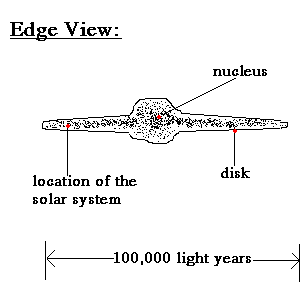 |
| *Assume Pluto's orbit to be the size of a ping-pong ball |
|---|
 |
| A group of about 25 galaxies including our own galaxy |
|---|
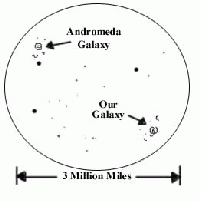 |
The Local Supercluster |
| A group of about 10 galaxy clusters, including the Local Group |
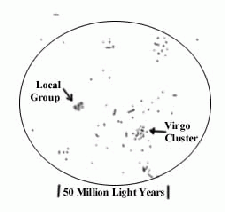 |
 |
1. Wave ModelLight is a wave of electromagnetic force |
|---|
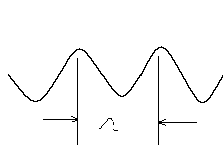 |
| Symbol | Definition | |
|---|---|---|
| Wavelength - Distance between wave crests | ||
| f | Frequency - Number of wave crests passing a fixed point per second |
|
| c | Wave Speed - Speed of a wave crest through space |
| The Relationship Between wavelength, frequency, and wave speed |
|---|
Note that the wave speed is fixed at 3 X 108m per second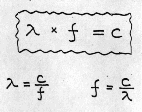 |
| Shorter wavelengths mean Higher frequencies |
| Longer wavelengths mean Lower frequencies |
2.
Photon Model
|
|---|
| EM radiation travels in discrete packets or (mass-less) "particles" of energy called photons |
| The
energy of a photon, E, is ... E = hf where h=Planck's constant (a fixed number) and, f=frequency |
| A display of the wavelengths, frequencies, or photon energies received from a source of electromagnetic radiation |
|---|
| Spectra may exist
in several forms: *Visual *Photographic, and *Graphical (example below) |
 |
| Band | Wavelength | Energy Per Photon |
|---|---|---|
| Radio | 108 to 10-1 cm | 1.24 X 10-12 to 1.24 X 10-3 eV |
| Infrared | 10-1 to 8 X 10-5 cm | 1.24 X 10-3 to 1.24 eV |
| Visible Light | 8 X 10-5 to 4 X 10-5 cm | 1.55 to 3.10 eV |
| Ultraviolet | 4 X 10-5 to 10-6 cm | 3.10 to 124 eV |
| X-Ray | 10-6 to 3 X 10-10 cm | 124 to 5 X 105 eV |
| Gamma-ray | 10-10 to 10-13 cm | 1.24 X 106 to 1.24 X 109 eV |
Note: The divisions between the various bands of the spectrum are somewhat arbitrary and different limits are frequently used by different researchers and in different books.
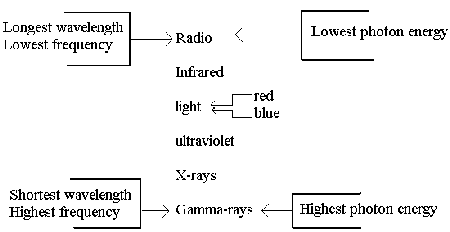 |
All travel at the speed of light. |